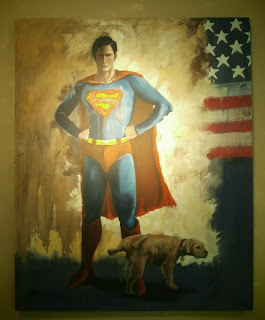The Southbank Centre is currently holding the annual
Koestler Trust exhibition ‘The Strength and Vulnerability Bunker’, showing art
by offenders, secure patients and detainees, giving an insight into the
personal feelings, regrets and hopes of people in secure settings. The Koestler
Trust was set up in 1962 by Arthur Koestler, who was jailed three times for
political reasons – the trust was created to encourage prisoners to occupy
their mind whilst building something positive out of their situation. Re-offending
affects us all, and the trust was set up as a way to show offenders that they
have something special and can improve their lives from it.
A stereotypical view of
the art world would be one of leisure – artists creating art, wealthy people
buying and displaying art, the public viewing art in galleries, the study of
art history or fine art – all very pleasant and leisurely appreciations of art.
However, since the mid 20th century art has been cultivated to be
used as a therapy for those with mental health issues or behavioural problems,
or a way to build something positive out of jail life, and this therapy has
proven to be incredibly useful when lowering depression and anxiety in the
mentally ill, as well as helping us understand offenders in jails. A lot of
speculation as to the effectiveness of art therapy is understandable – issues
aren’t spoken about or built on in the traditional sense, yet it is used as a
tool to express emotions with more accuracy than speaking can provide for
certain people.
The exhibition space and work shown were chosen and curated
by Speech Debelle, and the set up of the space itself is very impressive – the
area is split into three different sections, the bright yellow and frenetic
‘Strength’ area which leads into the dimmer and more ominous ‘Vulnerability’
section, which then leads into the beige coloured, calmer part to represent the
calm after the storm. The Strength section shows works of passion and hardship,
some of them are uncomfortable to see and hold a lot of emotion, one video in
particular from a mental health patient called ‘Tears on my Pillow’ includes a
lot of loud wailing that echos throught the exhibition hall, which is almost
disturbing, yet adds to the general feel of the bunker.
Emotions run high in the
art work, and they are a startling insight into the lives and feelings of the
people who have produced them, and personally I felt a great amount of sympathy
for them, despite the fact that a lot of these people were offenders and had
been jailed for a reason. Ironically, the theme for many of the art works is
‘forgiveness’, and this theme resulted in probably some of the most moving
pictures and paintings of families and acceptance – the especially poignant
ones are a set of 4 illustrations with titles like ‘How did we fail as
parents?’ and ‘Daddy is working away again’, showing that these prisoners are
aware of how they are viewed and that they need to address these issues.
Whilst the strength part of the exhibition showed powerful
images and work, the vulnerability area moved into deeper and sadder issues of
religion, hopelessness and isolation; religion seemed to be a strong theme
touched on by a few of the works, a particularly strong one of a man kneeling
in front of the first page of a bible whilst the moonlight creates crucifixes
on the floor from the window frame. Isolation was prominent too, with paintings
of people looking through windows or bars and over fences, which encourages the
fact that art is necessary in these environments as a link to the outside world
and a stimulating pass time from counting the minutes.
One thing in particular
that I noticed in this exhibition is that whilst some of the art is clearly
therapeutic, as their art works were basic but emotive, there was also a lot of
talent behind others. My favourite piece was a small sculpture that had been
made from bars of soap - it is exquisitely made yet addresses that in some
prisons there is a lack of resources to allow offenders to cultivate art
therapy. There are pieces of art made from such a wide variation of materials
including blue bin bags, bread and PVA glue, chicken bones and bottle tops. However,
we have to remember that physical art isn’t the only art available as a
therapy, and the written word can be just as powerful. Poetry and written work
were amongst the 7,300 entries that were submitted to the competition this
year, and the way these have been incorporated in the exhibition is clever and striking
– poems are painted on walls, looking almost reminiscent of a jail cell wall,
or extracts of poems and stories are hung from ceilings. These written words
are equally demonstrative of the emotions of prisoners and its clear that
writing can be a release for people who find it hard to verbally open up to
therapists.
The problem people may have with this exhibition is the haphazardness of the art works – some seem professionally done, some seem amateur, some are sculptures, videos, sounds, poems, paintings. It’s hard to take in so much at once, especially when there is no flowing theme between them, but if you take your time and appreciate the message and emotions behind each one there is definitely something you can take away from the exhibition. To me, this exhibition is a great show of what art therapy can produce, and the affects it can have on people who need it – by the end of the exhibition I felt like I had a deeper knowledge of emotions that I hadn’t even felt before, and I think this will resonate with me for a long time.
‘The Strength and Vulnerability Bunker’ showing until 1 December 2013 at Soutbank Centre






No comments:
Post a Comment